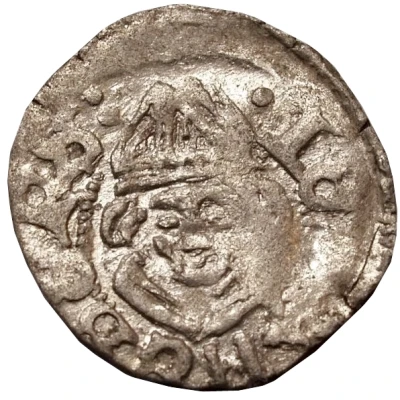


© Haljak Coin Auction
1 Pfennig - Johannes IV Duesborg Sword right; key left ND
| Billon | 0.39 g | 13 mm |
| Issuer | Bishopric of Dorpat (Livonian Confederation) |
|---|---|
| Bishop | Johannes IV Duesborg (1513-1514) |
| Type | Standard circulation coin |
| Years | 1513-1514 |
| Value | 1 Pfennig = ⅓ Schilling |
| Currency | Schilling (1422-1558) |
| Composition | Billon |
| Weight | 0.39 g |
| Diameter | 13 mm |
| Thickness | 0.5 mm |
| Shape | Round (irregular) |
| Technique | Hammered |
| Orientation | Variable alignment ↺ |
| Demonetized | Yes |
| Updated | 2024-10-06 |
| Numista | N#143712 |
|---|---|
| Rarity index | 100% |
Reverse
Crossed sword and key under three dots and surrounded by legend.
Script: Latin (uncial)
Lettering: MO · NO · TARPAT
Lettering (regular font): MO · NO · TARPAT
Translation:
Moneta Nova Darpatensis
New coin of Dorpat
Edge
Plain
Comment
While the legend states Johannes's name, which Johannes that is is not fully agreed upon. Some sources, like Federov, say this coin was minted under Johannes IV Duesborg (1513-1514); others, like Haljak, say they were minted under Johannes V Blankenfeld (1518-1527). The design of the Pfennigs definitely issued by Johannes V Blankenfeld are quite unique, and seeing as how the ruler who came before him, Christian Bomhower (1515-1518), switched from using the bust on the obverse to a crossed sword and key, it seems unlikely that Johannes V Blankenfeld would go back to the bust design. For that reason, the coins with Johannes's name will be listed under Johannes IV Duesborg here.Interesting fact
One interesting fact about this coin is that it was minted during a time of great turmoil in the region. The Bishopric of Dorpat was part of the Livonian Confederation, which was a loose alliance of territories in what is now Estonia and Latvia. In the early 16th century, the region was facing threats from neighboring powers, including the Grand Duchy of Moscow and the Teutonic Knights. Despite these challenges, the Bishopric of Dorpat was able to maintain its independence and continue minting its own coins, such as this 1 Pfennig coin featuring Johannes IV Duesborg.



